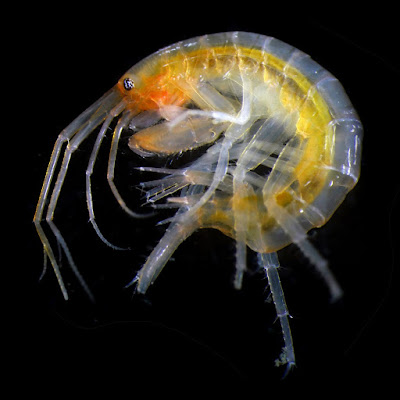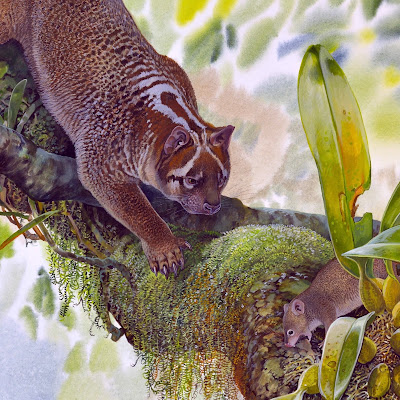[Most Recent Entries] [Calendar View]
Thursday, February 27th, 2020
| Time | Event | ||||
| 4:23a | [Crustacea • 2020] Species of the Maera-Clade (Amphipoda: Maeridae) collected from Japan. Part 3: Genera Maera Leach, 1814, Meximaera Barnard, 1969 and Orientomaera Ariyama, 2018 (addendum), with A Key to Japanese Species of the Clade
Abstract Two species of Maera Leach, 1814, a species of Meximaera Barnard, 1969 and a species of Orientomaera Ariyama, 2018 included in the Maera clade, are described from Japan. Maera loveni (Bruzelius, 1859) was collected from the Sea of Japan and can be distinguished from its congeners by the very large body size and the gnathopod 2 palm defined by a blunt tooth bearing a strong robust seta. Maera sagamiensis sp. nov. from Sagami Bay is characterized by the presence of small notches on the coxae 1–3. Meximaera mooreana (Myers, 1989) was collected from Wakayama Prefecture and has two distinct characters: the male gnathopod 2 with wide basis and the very long uropod 3. Morphological characters of the Japanese specimens resemble well those in the literature, but the mandibular palp article 1 is projected acutely. Orientomaera incisa sp. nov. was recently collected from Wakayama Prefecture and its gnathopods 2 in both sexes bear a distinctive incision on the palm. Keys to species of Meximaera in the world and Japanese species of the Maera-clade are provided. Fifteen species included in the Maera-clade occur in Japan. Keywords: Taxonomy, Crustacea, Amphipoda, Maeridae, Maera, Meximaera, Orientomaera, Japan, new species, key Maera sagamiensis sp. nov. Hiroyuki Ariyama. 2020. Species of the Maera-clade collected from Japan. Part 3: Genera Maera Leach, 1814, Meximaera Barnard, 1969 and Orientomaera Ariyama, 2018 (addendum), with A Key to Japanese Species of the Clade (Crustacea: Amphipoda: Maeridae). Zootaxa. 4743(4); 451–479. DOI: 10.11646/zootaxa.4743.4.1 | ||||
| 10:07a | [Ornithology • 2020] Untangling Cryptic Diversity in the High Andes: Revision of the Scytalopus [magellanicus] complex (Rhinocryptidae) in Peru reveals Three New Species Abstract Tropical mountains feature marked species turnover along elevational gradients and across complex topography, resulting in great concentrations of avian biodiversity. In these landscapes, particularly among morphologically conserved and difficult to observe avian groups, species limits still require clarification. One such lineage is Scytalopus tapaculos, which are among the morphologically most conserved birds. Attention to their distinctive vocal repertoires and phylogenetic relationships has resulted in a proliferation of newly identified species, many of which are restricted range endemics. Here, we present a revised taxonomy and identify species limits among high-elevation populations of Scytalopus tapaculos inhabiting the Peruvian Andes. We employ an integrated framework using a combination of vocal information, mitochondrial DNA sequences, and appearance, gathered from our own fieldwork over the past 40 yr and supplemented with community-shared birdsong archives and museum specimens. We describe 3 new species endemic to Peru. Within all 3 of these species there is genetic differentiation, which in 2 species is mirrored by subtle geographic plumage and vocal variation. In a fourth species, Scytalopus schulenbergi, we document deep genetic divergence and plumage differences despite overall vocal similarity. We further propose that an extralimital taxon, Scytalopus opacus androstictus, be elevated to species rank, based on a diagnostic vocal character. Our results demonstrate that basic exploration and descriptive work using diverse data sources continues to identify new species of birds, particularly in tropical environs. Keywords: integrated taxonomy, Neotropics, systematics, tapaculo, vocalizations Scytalopus krabbei sp. nov. [T. S. Schulenberg, D. F. Lane, A. J. Spencer, F. Angulo, and C. D. Cadena] White-winged Tapaculo Etymology: The modern knowledge of the systematics of Scytalopus, including recognition of a level of diversity in the genus that would have astounded earlier generations of ornithologists, is largely due to Niels K. Krabbe, through his careful and thorough research both in the field and in the collection. Having himself contributed to the descriptions of no fewer than 7 new taxa of Scytalopus, we take great pleasure in taking the opportunity to name this new species in honor of our friend and colleague. The proposed English name refers to the small patch of white on the wing coverts, a feature—otherwise unusual in tapaculos—that is present on all known S. krabbei specimens. Scytalopus frankeae sp. nov. [K. V. Rosenberg, T. J. Davis, G. H. Rosenberg, P. A. Hosner, M. B. Robbins, T. Valqui, and D. F. Lane] Jalca Tapaculo Etymology: We are pleased to name this new tapaculo in honor of Dr. Irma Franke, our friend, colleague, former curator of the bird collection at the MUSM, and a major contributor to Peruvian ornithology for over 30 yr. It is especially fitting to name this taxon after her because she participated in the Millpo expedition that discovered the bird in 1985. The recommended English name uses a local Peruvian term for puna and páramo habitat (“jalca”) that has tussock grasses as a primary component, which was the habitat primarily used by the species at the type locality (although less so in Junín). Colloquially, this species has been called Millpo Tapaculo. However, we consider this name to be inappropriate, primarily because Millpo is now known to be at the geographic periphery of the range of the species. Our proposed English name is more reflective of the habitat of S. frankeae throughout its distribution. Scytalopus whitneyi sp. nov. [N. K. Krabbe, J. Fjeldså, P. A. Hosner, M. B. Robbins, and M. J. Andersen] Ampay Tapaculo Etymology: We take the opportunity to honor our friend and colleague Bret M. Whitney for his outstanding contributions to Neotropical ornithology over the past 3 decades. Bret’s keen eyes and ears, and his insightful attention to vocalizations and natural history, have given us a much greater understanding of variation and species limits in several challenging groups of tropical birds, and particularly in Scytalopus. The recommended English name refers to Bosque Ampay, the only protected area where the species occurs. Niels K. Krabbe, Thomas S. Schulenberg, Peter A. Hosner, Kenneth V. Rosenberg, Tristan J. Davis, Gary H. Rosenberg, Daniel F. Lane, Michael J. Andersen, Mark B. Robbins, Carlos Daniel Cadena, Thomas Valqui, Jessie F. Salter, Andrew J. Spencer, Fernando Angulo and Jon Fjeldså. 2020. Untangling Cryptic Diversity in the High Andes: Revision of the Scytalopus [magellanicus] complex (Rhinocryptidae) in Peru reveals Three New Species. The Auk. ukaa003. DOI: 10.1093/auk/ukaa003 RESUMEN: Las zonas montañosas tropicales se caracterizan por un alto grado de reemplazo de especies a través de gradientes altitudinales y de topografías complejas, lo cual se manifiesta en una alta concentración de diversidad aviar. En estos paisajes, particularmente en grupos aviares con morfología conservada y difíciles de observar, los límites entre especies aún requieren ser aclarados. Uno de estos linajes es el género Scytalopus, que reúne a algunas de las aves con morfología más conservada. Estudios enfocados en las diferencias en repertorio vocal y relaciones filogenéticas han conducido a una proliferación de descripciones de especies nuevas, muchas de las cuales son endémicas con distribuciones muy restringidas. Presentamos una revisión taxonómica e identificamos límites de especies entre poblaciones de Scytalopus de grandes elevaciones de los Andes peruanos. Empleamos un enfoque integrado que combina información de vocalizaciones, de secuencias de ADN mitocondrial y de caracteres del plumaje. Los datos fueron obtenidos mediante nuestro trabajo de campo en los últimos 40 años, complementados con información de archivos de sonidos y especímenes de museo. Describimos tres nuevas especies endémicas de Perú. Dentro de las tres existe diferenciación genética, que en dos casos se asocia con variación geográfica sutil en plumaje y vocalizaciones. Documentamos que en una cuarta especie, Scytalopus schulenbergi, existe divergencia genética profunda y variación en plumaje a pesar de que las poblaciones son similares vocalmente en general. Además, proponemos que un taxón de otra región, Scytalopus opacus androstictus, se eleve al rango de especie, con base en un carácter vocal diagnóstico. Nuestros resultados demuestran que las exploraciones básicas y un trabajo descriptivo basado en fuentes de datos diversos sigue permitiendo identificar nuevas especies de aves, particularmente en ambientes tropicales. | ||||
| 3:09p | [Mammalogy • 2020] Ailurus fulgens & A. styani • Genomic Evidence for Two Phylogenetic Species and Long-term Population Bottlenecks in Red Pandas
Abstract The red panda (Ailurus fulgens), an endangered Himalaya-endemic mammal, has been classified as two subspecies or even two species – the Himalayan red panda (A. fulgens) and the Chinese red panda (Ailurus styani) – based on differences in morphology and biogeography. However, this classification has remained controversial largely due to lack of genetic evidence, directly impairing scientific conservation management. Data from 65 whole genomes, 49 Y-chromosomes, and 49 mitochondrial genomes provide the first comprehensive genetic evidence for species divergence in red pandas, demonstrating substantial inter-species genetic divergence for all three markers and correcting species-distribution boundaries. Combined with morphological evidence, these data thus clearly define two phylogenetic species in red pandas. We also demonstrate different demographic trajectories in the two species: A. styani has experienced two population bottlenecks and one large population expansion over time, whereas A. fulgens has experienced three bottlenecks and one very small expansion, resulting in very low genetic diversity, high linkage disequilibrium, and high genetic load. Ailurus fulgens F. Cuvier, 1825 Ailurus styani Thomas, 1902 Yibo Hu, Arjun Thapa, Huizhong Fan, Tianxiao Ma, Qi Wu, Shuai Ma, Dongling Zhang, Bing Wang, Min Li, Li Yan and Fuwen Wei. 2020. Genomic Evidence for Two Phylogenetic Species and Long-term Population Bottlenecks in Red Pandas. Science Advances. 6(9); eaax5751. DOI: 10.1126/sciadv.aax5751 Red panda genes suggest there are actually two different species newscientist.com/article/2235500-red-pan | ||||
| 3:16p | [PaleoMammalogy • 2020] Lekaneleo, A New Genus of Marsupial Lion (Marsupialia, Thylacoleonidae) from the Oligocene–Miocene of Australia, and the Craniodental Morphology of L. roskellyae, comb. nov.
ABSTRACT The domestic cat-sized marsupial lion Priscileo roskellyae (Thylacoleonidae) from the Oligocene–Miocene of Australia was originally allocated to the genus Priscileo Rauscher, 1987, on the basis of its plesiomorphic upper dental formula of three premolars and four molars and its relatively small size. Recent reassignment of the Priscileo type species P. pitikantensis to the genus Wakaleo has now necessitated establishment of a new generic name for the species roskellyae Gillespie, 1997. In contrast to W. pitikantensis, which is only known from a fragmented palate and associated postcranial elements, the skull and lower dentition of P. roskellyae, described here, exhibit features that support its generic distinction within Thylacoleonidae. It is renamed here Lekaneleo roskellyae, comb. nov. Distinctive craniodental features include small sagittal and nuchal crests, lack of a prominent rostral tympanic process on the periotic, lack of alisphenopalatine pterygoid processes, a stylomastoid sulcus that courses through the mastoid, three teeth between i1 and p3, and very broad talonid basins on the lower molars. In contrast to species of Wakaleo, which appear to form a morphocline during the late Oligocene and early Miocene, L. roskellyae is a relatively conservative taxon, exhibiting no discernible change over the same interval of time. SYSTEMATIC PALEONTOLOGY Class MARSUPIALIA Illiger, 1811 Order DIPROTODONTIA Owen, 1866 Suborder VOMBATIFORMES Woodburne, 1984 Family THYLACOLEONIDAE Gill, 1872 LEKANELEO, gen. nov. Type and Only Species— Lekaneleo roskellyae, comb. nov. Etymology— ‘lekane’ is derived from Greek meaning ‘basin’ and refers to the broad talonid basins present on the lower molars; ‘leo,’ which is Latin for ‘lion,’ is the stem term for all members of the family Thylacoleonidae. The genus is assigned feminine gender. LEKANELEO ROSKELLYAE, comb. nov. Priscileo roskellyae Gillespie, 1997: figs. 1–3.
Anna K. Gillespie, Michael Archer and Suzanne J. Hand. 2020. Lekaneleo, A New Genus of Marsupial Lion (Marsupialia, Thylacoleonidae) from the Oligocene–Miocene of Australia, and the Craniodental Morphology of L. roskellyae, comb. nov. Journal of Vertebrate Paleontology. DOI: 10.1080/02724634.2019.1703722 |
| << Previous Day |
2020/02/27 [Calendar] |
Next Day >> |













